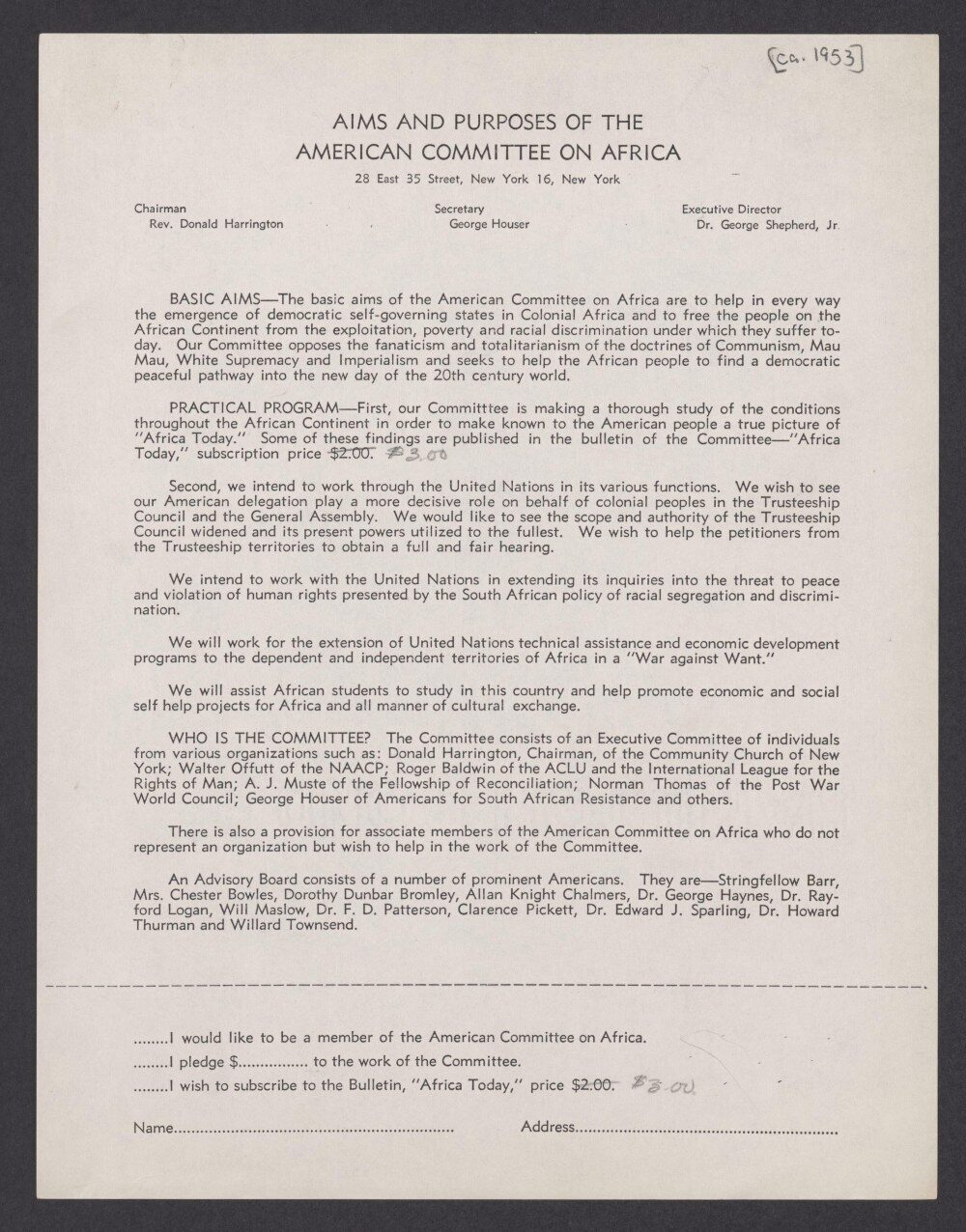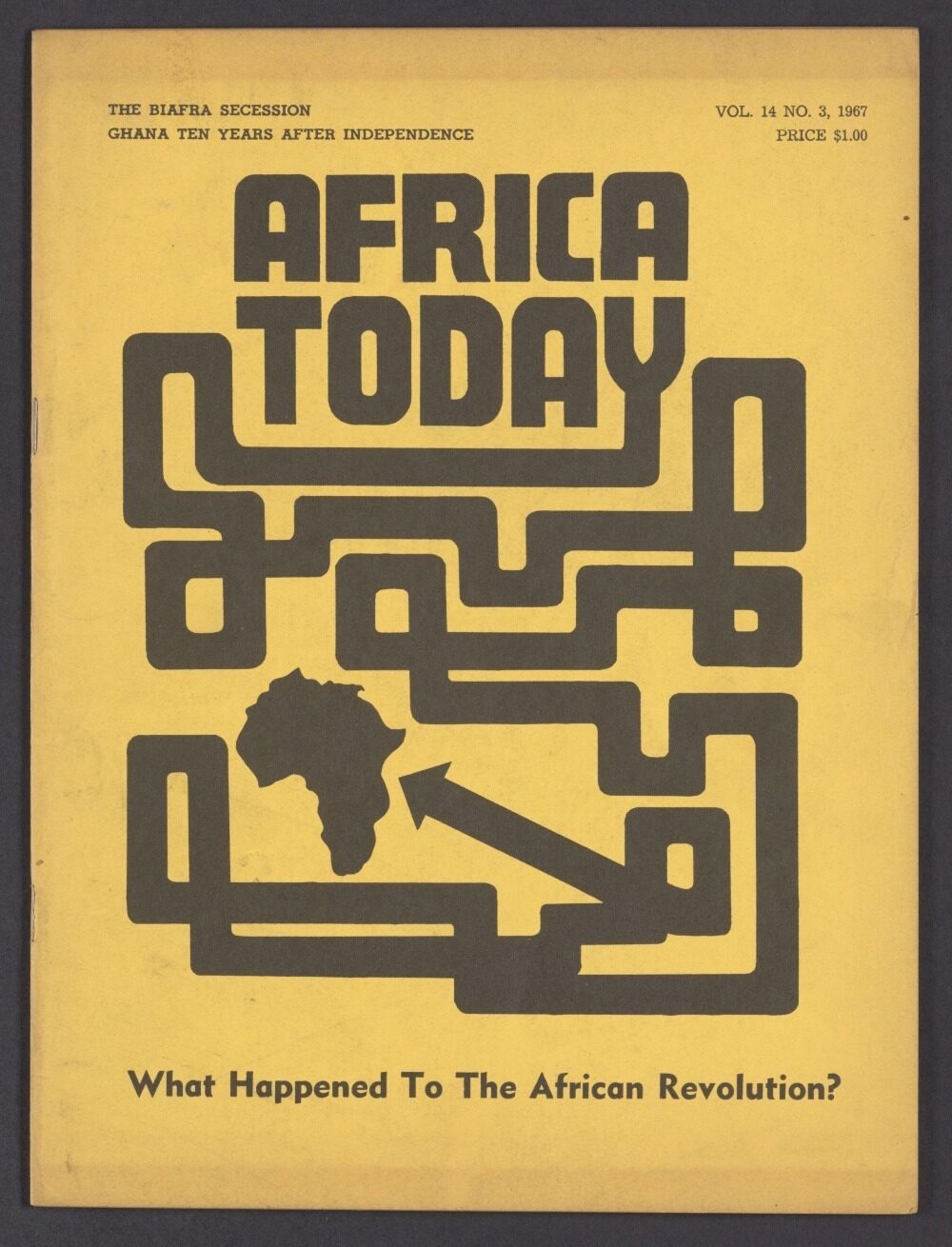Forging “new links between the America and the Africa of today and tomorrow.”
The American Committee on Africa and grassroots activism across two continents
In America, individuals and organizations are being compelled by the march of events to pay heed for the first time to a vast new portion of the world, familiar until recently only to a handful of missionaries and traders. Some have great expectations, some have great fears, but few have much information.
Filling this information gap became the primary goal of the American Committee on Africa (ACOA), with a commitment to reach as many members of the American public as possible. Prioritised in the organisation’s aims and purposes – ahead of top level interaction with the UN and the US government – the ACOA had a desire first and foremost to make “a thorough study of the conditions throughout the African continent in order to make known to the American people a true picture of ‘Africa Today’.”

Aims and Purposes of the American Committee on Africa, Statement of Purpose and Organization, 1953.
Sourced from Amistad Research Center, New Orleans, LA
This focus was driven by a belief in the collective power of small actions by individuals and is evidenced in much of the archival material found in AM’s collection American Committee on Africa, Module I: Liberation Movements, Solidarity and Activism, sourced from the Amistad Research Center, New Orleans. The ACOA’s aims and purposes included a realisation that to “achieve these ends, the committee must command the confidence and the support of the largest possible number of those persons…”. Reaching the American public was made possible by the introduction of the committee’s newsletter, Africa Today, launched in its full form 70 years ago in 1954. Circulation of this publication provided the means to inform, but gaining the confidence and support of its readership (and thereby galvanising readers to act) meant reporting information that was not only well-researched and trustworthy, but also inspiring.
An early statement from the formation of the committee in 1953 shows a strong commitment to providing factual and unbiased information in order to engender this trust from its members, but providing the inspiration meant giving something more than just thoroughly researched information – it meant providing the personal connection, the voice of experience. From the earliest issues of the Africa Today bulletin, a supplement titled ‘Africa Speaks’ was often added on which provided a platform for the voices of African liberation, independence and anti-apartheid movements to speak directly to the US readership. The introduction to this supplement stated:
“With each issue, ‘Africa Today’ will give a nationalist spokesman from one of the colonies or protectorates of Africa a chance to air his countrymen’s point of view, as we believe their viewpoints are important.”
As the reach of Africa Today grew, the more the content started to include direct calls to action for its readers. By the 1960s we see the addition of a section called ‘Action Notes’, detailing current campaigns and providing information about the ways in which individuals could contribute to a cause. It gave its readers agency, and evidence of how their actions were bringing about change over time. A 1967 edition of Africa Today detailed in the ‘Action Notes’ that up to that point a total of $23 million had been withdrawn from Chase National Bank and First National City Bank as a result of the Bank Boycott Campaign. Many of the individuals who participated in such campaigns forwarded their correspondence with the banks in question to the ACOA (copies of which can be found in American Committee on Africa: Liberation Movements, Solidarity and Activism), providing an archival record of the increasingly large number of American individuals that were using it as a means to protest against US investment in the apartheid regime in South Africa.

Africa Today, Vol.14, No.3, 1967
Sourced from Amistad Research Center, New Orleans, LA
As the ACOA grew in size and influence, taking on causes of equality and liberation across the African continent and engaging with US policy at the highest level, this commitment to inspiring grassroots action never wavered. In a time of tumultuous post-colonial and Cold War politics, the organisation maintained its faith in the power of social conscience.
Africa Today is still in circulation today, outlasting the ACOA itself but providing a legacy by maintaining a commitment to research and a venue for the opinions and perspectives of contributors not just from Africa and America, but across the world.
American Committee on Africa, Module I: Liberation Movements, Solidarity and Activism is available now. Material sourced from Amistad Research Center, New Orleans. The images featured in this blog are open-access for 30 days and can be found here:
Statement of Purpose and Organization, 1953
ACOA printed items: Africa Today newsletter, 1967
For more information on this resource, including free trial access and price enquiries, please email us at info@amdigital.co.uk.
Recent posts

The blog highlights American Committee on Africa, module II's rich documentation of anti-apartheid activism, focusing on the National Peace Accord, global solidarity, and student-led divestment campaigns. It explores the pivotal role of universities, protests, and public education in pressuring institutions to divest from apartheid, shaping global attitudes toward social justice and reform.

This blog examines how primary sources can be used to trace the impact of young voices on society, particularly during pivotal voting reforms in the UK and the US. Explore materials that reveal insights into youth activism, intergenerational gaps, and societal perceptions, highlighting their interdisciplinary value for studying youth culture, activism, and girlhood across history.
